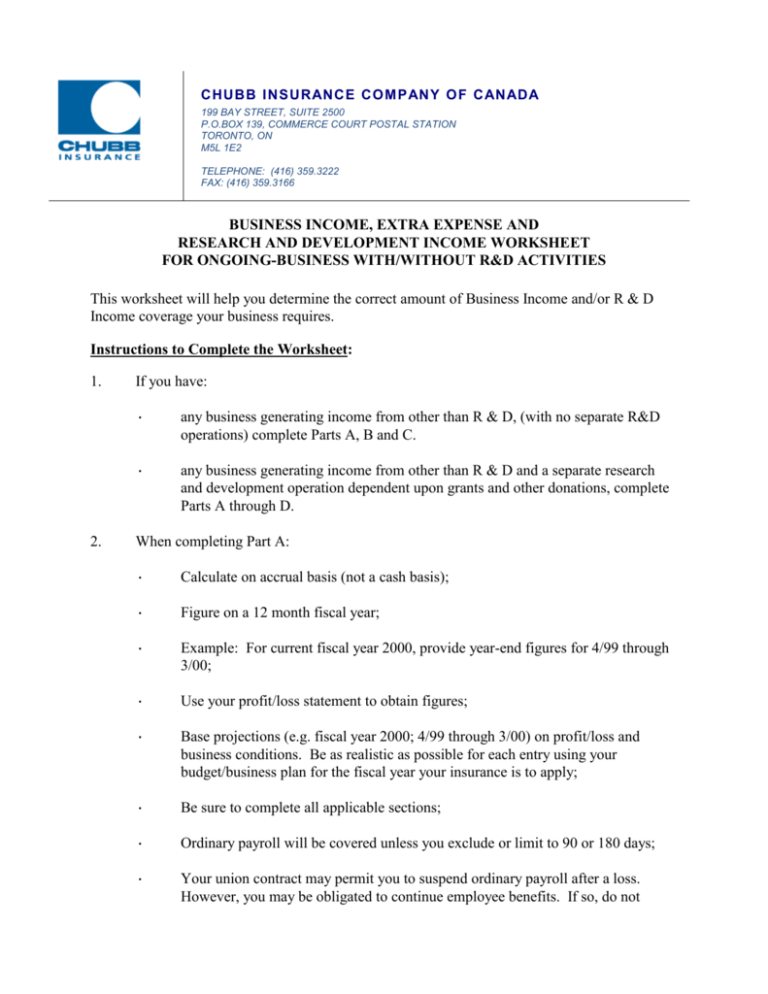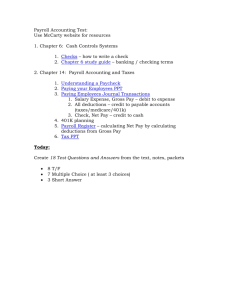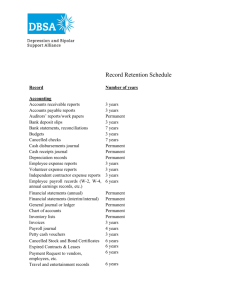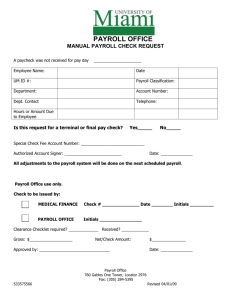Business Income & Extra Expense Application
advertisement

CHUBB I NSURANCE CO M PANY O F CANADA 199 BAY STREET, SUITE 2500 P.O.BOX 139, COMMERCE COURT POSTAL STATION TORONTO, ON M5L 1E2 TELEPHONE: (416) 359.3222 FAX: (416) 359.3166 BUSINESS INCOME, EXTRA EXPENSE AND RESEARCH AND DEVELOPMENT INCOME WORKSHEET FOR ONGOING-BUSINESS WITH/WITHOUT R&D ACTIVITIES This worksheet will help you determine the correct amount of Business Income and/or R & D Income coverage your business requires. Instructions to Complete the Worksheet: 1. 2. If you have: · any business generating income from other than R & D, (with no separate R&D operations) complete Parts A, B and C. · any business generating income from other than R & D and a separate research and development operation dependent upon grants and other donations, complete Parts A through D. When completing Part A: · Calculate on accrual basis (not a cash basis); · Figure on a 12 month fiscal year; · Example: For current fiscal year 2000, provide year-end figures for 4/99 through 3/00; · Use your profit/loss statement to obtain figures; · Base projections (e.g. fiscal year 2000; 4/99 through 3/00) on profit/loss and business conditions. Be as realistic as possible for each entry using your budget/business plan for the fiscal year your insurance is to apply; · Be sure to complete all applicable sections; · Ordinary payroll will be covered unless you exclude or limit to 90 or 180 days; · Your union contract may permit you to suspend ordinary payroll after a loss. However, you may be obligated to continue employee benefits. If so, do not exclude employee benefits and document worksheet accordingly if you exclude (or limit) ordinary payroll. · Ordinary payroll includes your payroll for all your employees except: - · officers; executives; department managers; employees under contract; and others specified in your policy declarations or attached to this worksheet in separate listing by job classification or employees whose payroll is to be covered. Ordinary payroll comprises: - the payroll for the ordinary payroll; benefits you pay for the ordinary payroll; social security (FICA) you pay for the ordinary payroll; union dues you pay for the ordinary payroll; and workers compensation insurance you pay for the ordinary payroll. 3. Be sure to complete the Extra Expense Worksheet (Parts B & C) in addition to Part A so that you will purchase the proper Combined Business Income/Extra Expense Limit of Insurance. 4. The beginning and ending inventories in all calculations should be based on the same valuation method. Business Income/Extra Expense Worksheet PART A – BUSINESS INCOME Note: Disregard lines 2 and 3 if you do not manufacture finished stock. See definitions. Line REVENUE/INCOME Year-end figures for / / Projection figures for / / 1. Gross sales (net of city and state sales taxes) Finished Stock Inventories (meaning stock you have manufactured) Ignore lines 2 and 3 if you do not manufacture: Sales value at beginning of year $ $ + + + + + + + + + + = = $ + $ + + + + + + = + = $ $ 2. 3. 4. 5. 6. 7. 8. 9. 10. 11. 12. 13. Sales value at end of year Add your other income: Commission or rents Cash discounts you received from vendors, etc. If you purchase Research and Development Income Coverage complete part D and include the net amount from line 3 of part D All other income (i.e.: licensing fees, royalties, etc.) Minus Deductions for Returns and Allowances Discounts granted to customers Prepaid Outgoing Freight Bad Debts Your Collection Expenses 100% Revenue/Income (sum of lines 1 – 12) 17. EXPENSES/DEDUCTIONS Purchases including incoming transportation costs: Raw Stock or Merchandise Factory or Operational Supplies Consumed Services purchased from outsiders, not under contract(i.e.: subcontract costs/work in progress services/production services) Non-contracted power, heat and refrigeration expenses may be deducted only if you are a manufacturer and your policy excludes these expenses from the coverage 18. Inventories (for manufacturing include raw stock and stock in process of manufacture, but not finished stock; for nonmanufacturing, inventories): Beginning of year inventory 14. 15. 16. 19. 20. 21. End of year inventory Total Expenses/Deductions (sum of lines 14 – 19) 100% Business Income, including ordinary payroll, for 12 month fiscal year (subtract line 20 from line 13) Purchase the Limit of Insurance you require, either less than or more than the 100% amount in line 21. But if ordinary payroll is to be excluded or limited to 90 or 180 days, complete the next page, otherwise go to Parts B & C. Part A – Business Income, continued 29. 100% of ordinary payroll (includes benefits, social security and union dues, you pay plus workers’ comp premium all for the ordinary payroll). Payroll for ordinary payroll Benefits you pay for ordinary payroll FICA you pay for ordinary payroll Union Dues you pay for ordinary payroll Workers Comp Premium for ordinary payroll Total 100% Business Income excluding ordinary payroll (subtract line 27 from line 21) Purchase the Limit of Insurance you require, either less than or more than the 100% BI excluding ordinary payroll on line 28 30. If ordinary payroll is to be covered for only 90 or 180 days, what is your largest 90 or 180 payroll (include all components of the payroll) 22. 23. 24. 25. 26. 27. 28. 31. Add lines 29 and 30 to determine your business income Limit of Insurance with only 90 or 180 days or ordinary payroll coverage Note: whichever limit you select you should consider adding an additional amount to cover extra expenses (See Part B) *Finished Stock $ + + + + = $ + + + + = = = $ $ $ $ $ $ Finished stock means goods you have manufactured which are in their completed state and ready for sale. Finished stock doesnot include goods you have manufactured which are in their completed state and ready for sale on the premises of any retail outlet insured by Business Income Insurance. Note: If your finished stock inventory is on a cost basis, convert to selling price; eg: total sales ($1,500,000) divided by total costs ($1,000,000) equals a factor of 1.5. Multiply cost inventory by 1.5 to determine the selling price inventory. Name of Insured: Individual completing this worksheet by (Name): Title: ______________ Signature: Date: Agent: EXTRA EXPENSE WORKSHEET Part B – Extra Expense 1. 2. 3. This worksheet is designed to help you determine the extra monthly costs necessary to continue operations as your business recovers after a physical loss. Be sure to include extra expense you will incur in your research and development operations. Typically the start-up (1st month) and close down (last month) will have larger extra expenses than the intervening months following a loss. 1st month Rent: Temporary location Temporary fixtures, machinery and equipment Moving and hauling Installation of operations at temporary location Light, heat and power at temporary location Maintenance at temporary location Insurance at temporary location Employees expenses Transportation Payroll incidentals Overtime Nightwork Travel allowances Incentives Additional staff Advertising Telephone and communications (installation and maintenance at temporary location) Engineering and administrative costs Emergency facilities Transporting supplies and materials to temporary location Net cost of services purchased Net amount paid to others for processing and manufacturing Net cost of property and equipment purchased for temporary site. (Note: Please consider the “sale” or “salvage” value of property and equipment after restoration) Additional freight and shipping costs due to temporary location Automobile rentals Bonuses paid Additional Utility Excess Demand Charges Other To complete calculation, carry totals (A), (B) and (C) to next page TOTALS Intervening Months Last Month $ + + + + + + $ + + + + + + $ + + + + + + + + + + + + + + + + + + + + + + + + + + + + + + + + + + + + + + + + + + + + + + + + + + + + + + + + + + = + + + + + + + = + + + + + + + = (A) (B) (C) Check with your agent or broker for assistance and information concerning Chubb’s software for disaster planning, Chubb Factor. Extra Expense, continued Determining Total Extra Expense Dollar Requirements Base your calculations on the longest foreseeable recovery period, in order to ensure adequate coverage. Line 1. 2. 3. 4. 5. 6. Total extra expense per month for each subsequent month following loss carry over (B) from prior page. Number of months required to recover from total destruction of property excluding first and last months if Extra Expense dollars are spent. (BE CONSERVATIVE) Total extra expense for all months except first and last months (LINE 2 x LINE 1) Total extra expense for first month following loss, carry over (A) from prior page. Total extra expense for last month following loss, carry over (C) from prior page. Estimated total extra expense dollars for full recovery period. (SUM OF LINES 3, 4, & 5) $ x =$ +$ +$ =$ Part C. Combined Business Income And Extra Expense To determine the affect of Extra Expense dollars on Business Income Coverage, complete the calculation below. Base estimates on total destruction of property. 7. 8. 9. 10. 11. 12. 13. 14. 15. Projected 12 month Business income from Business Income worksheet (Part A, Line 21; if ordinary payroll is to be excluded or limited, Line 28 or 31.) Your Estimated 12 month business income amount you think you will require to insure the worst possible loss. (May differ from line 7 above). This is based on your analysis of operations and represents the amount you think you will require for 12 months based on the worst possible loss. BE CONSERVATIVE; eg: Review expenses on your P&L statement not eligible for entry under Part A, Expenses/Deductions. Determine if any may be reduced and, if so, by how much. Subtract the sum of your reductions from line 7 to arrive at the BI amount you think you will require for 12 months following a total loss to your property, but before the implementation of any disaster plan. (Extra expense dollars pays for the implementation.) BE CONSERVATIVE Your estimate of total number of months from date of physical loss until operations/sales are back to normal if extra expense dollars were not spent and you did not conduct any business during restoration. BE CONVERSATIVE Your estimate of business income dollars required for loss duration (modify line 8 by the number of months in line 9; eg: line 9, 15 months, multiply line 8 by 125%; or line 9, 10 months, multiply line 8 by 83.3%). (CAUTION: MODIFY IF SEASONAL BUSINESS) Your estimated percentage by which the business income loss (line 10) can be reduced by spending extra expense dollars (line 6) thereby mitigating loss and staying in the market place to some degree. BE VERY CONSERVATIVE. This is in addition to the number of months spending extra expense dollars will reduce the timeframe to restore your business. Your estimate of the amount the business income loss is reduced (multiply 10 by line 11). Your estimate of the remaining business income loss, (subtract line 12 from line 10). Total extra expense dollars (line 6). Your estimate of the limit of insurance for combined business income and extra expense for the worst possible physical loss and duration of loss you can foresee. (Add lines 13 and 14). $ $ $ % =$ =$ +$ =$ PART D – LOSS OF RESEARCH AND DEVELOPMENT INCOME (Not to be used when Business income is requested for other than R&D operations) List of grants, endowments and other financial contributions. We suggest that you review this list with your financial consultant at least quarterly so that any necessary modifications in your insurance may be made. Description (Include donor and purpose of donation) Term Amount of Contribution $ $ $ $ $ $ $ $ $ $ $ 1. 2. 3. What grants, endowments and other financial contributions will be available to you during the coming year to further your research and development operations (do not include commercial financing transactions, including, but not limited to public offerings of stocks, bonds or other securities; loans or lines of credit). Please list and describe each contribution individually in the space provided above, or on a separate sheet(s) of paper. Please include the amount of the contribution. MINUS Total R & D expenses that would not continue to be incurred; eg: Deduct any expenses involved in your R&D operations that you think you will not have to continue to pay during restoration, such as, but not limited to: · payroll expenses; · cost of supplies and materials including incoming transportation costs; · services purchased from outsiders who are not under contract; and · any other R&D expense you are confident you will not be obligated to pay. 100% Loss of Research and Development Income. (Subtract line 2 from line 1). (See line 6, Part A, Business Income).






